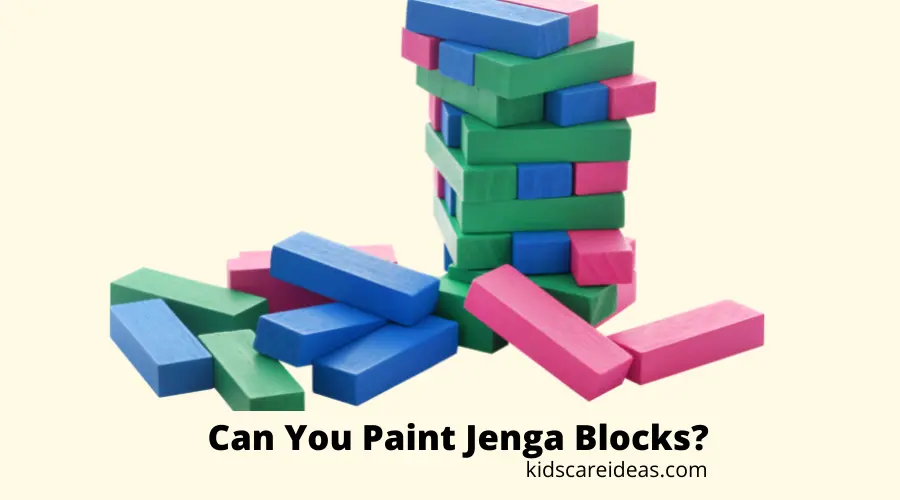Jenga is very fun to play but I was wondering whether you can paint Jenga blocks.
This made me do the research on the types of paints that are good for Jenga blocks, wooden block paint that would maintain its slippery feel.
So, Can You Paint Jenga Blocks? Jenga blocks can be painted with colors. In fact, painting on these blocks with different colors or designs adds more fun to playing the game compared to playing with just regular wood blocks.
You can use acrylic paints to paint your Jenga Blocks.
Jenga is a classic building block game that is very popular worldwide.
It is a great way to exercise your hand-eye coordination and creativity.
The game is simple – you take turns stacking blocks until the tower falls.

Let’s get started!
Why would you Paint Jenga Blocks?
There are a lot of good reasons to paint Jenga blocks.
- One of them is when it’s a rainy day and you’re bored, it gives you something to do.
- Another reason is to upgrade its look from a plain block of wood to a fun and colorful one.
- Lastly, it’s because it prevents the wooden block from deteriorating. Since it’s made of wood, a protective coating like paint would make it last longer as compared to leaving it bare.
What Kind of Paint do You Use on Jenga Blocks?
Different kinds of paint can be used on Jenga blocks but the best paints to use for painting thin layers on wood like these blocks are acrylic paints that are artist’s grade.
This type of paint would usually require one to two layers of paint and are easy to work with.
Another option would be spray paint.
Enamel paint will also work but it requires more than two coats, and it takes longer to dry compared to acrylic and spray paint
Can I use Watercolor Paint?
Watercolor paint isn’t advisable for painting on surfaces like wood and since Jenga blocks are mostly made of wood, it’s not a good idea to use watercolor.
Although it’s the easiest paint that you can access since you can just buy it from your local art supplies store, the wood will soak up the paint and it will come off on your hands and clothes when you play the game, and your table will get painted, and it’ll make them too slippery to play with.
Another thing when painting Jenga blocks with watercolor is that when the wood absorbs the water from the paint, it could cause the wood to expand thus, changing the sizes of most of the blocks.
Wood absorbing water could also lead to the block rotting, and we wouldn’t want to play with rotted Jenga blocks.
Are Spray Paints good for Painting Jenga Blocks?
Spray paints can be good for painting Jenga blocks as they are water-resistant, and dry quickly.
They are also easy to use and there are spray paints that are designed for wood available in your local art supplies store.
It also adds a nice finish to the Jenga block and can be used on many different materials as well.
How Do you Color Jenga Blocks?
Here are the steps you need to know how to color Jenga blocks:
- When coloring Jenga blocks using acrylic paint, it’s best to sand all the edges of the blocks first using sandpaper that has a fine grade.
- After sanding the blocks, wipe the blocks using a paper towel or a brush to make sure there isn’t any dust left.
- The surface of the blocks should be smooth and dust-free. Place a newspaper on a flat surface and place the blocks on top then you can start painting the blocks using a brush and your acrylic paint with a little bit of water.
- Evenly paint the blocks and once done, leave them to dry. Once the paint dries, best seal the painted surface with clear acrylic spray paint.
- For spray painting, like acrylic paint, prepare the blocks first by sanding them on four sides and removing the excess dust so that the blocks are smooth and dust-free.
- Afterward, lay a newspaper or carton on a flat surface and place the blocks on top.
- Once the blocks are placed, you can start to spray paint them, make sure the surfaces are evenly spray-painted, and once done, leave the blocks to dry and finish it off with a coat of clear acrylic spray paint.
How to Make Painted Jenga Blocks Slippery?
Painted Jenga Blocks may tend to stick to each other and might impact your normal gameplay.
If Jenga Blocks are not slippery after it is painted you will have difficulty playing the game and it may also cause your Jenga tower to fall.
Here are the steps to make the Jenga Blocks Slippery:
- To make painted Jenga blocks slippery, you need to ensure that the paint is only glossed and that there are no bumps or roughness on the surface of the block.
- To do this you will need a fine grade of sandpaper usually between 80 to 100 grit and a paintbrush. With the brush, apply some water over the surface of the block.
- Take your fine-grade sandpaper, and gently sand in circles over all surfaces of the block to polish off any bumps or glue residues that would otherwise cause friction when one block is placed on top of another.
- Then wash off any remaining dust with a damp cloth and start painting.
- Apply two coats of polyurethane with a foam brush, letting each coat dry overnight before applying the next one, as a finishing coat as it not only protects the paint from scratching off in play but also makes the blocks more slippery.
What Games Can You Play With Painted Jenga Blocks?
Other than Jenga itself, you could also play a game like tic tac toe by drawing circles for one player and Xs for another.
When it’s your turn, you take out a block with one of those pictures on it and put it in the grid until somebody wins.
You can also use the painted Jenga blocks as an icebreaker where you can paint numbers that corresponds to a certain question and each time a person takes out a block, he should answer the question corresponding to the number painted on the Jenga block.
Truth or Dare can also be played using painted Jenga blocks.
Divide the blocks into two groups and paint them in different colors like red and blue.
When someone pulls out a blue, they should play truth and when someone pulls out a red, they should play dare.
Conclusion
Let’s conclude the post on whether you can Paint Jenga Blocks!
It can be fun to color Jenga Blocks and a unique way to show off your creative side.
Not to mention, it can also be a great way to bond with friends or family members.
So, if you are looking for a new and exciting project, consider painting your Jenga blocks!
So why not give it a try?
I hope you liked reading the post.
